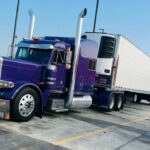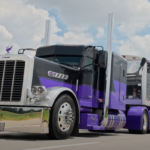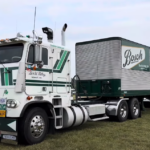Walmart’s supply chain leaders recognized the need for a change when apps were causing difficulties for drivers and failing to provide real-time visibility of their assets and loads.
After driving for Walmart for around nine years, Carol Nixon remembered using three driver workflow apps that were outsourced and failed to meet expectations.
“Some of the other programs we used before were so not compatible with what we needed to do. It was frustrating. You’d spend more time messing with it and having to pull over to get it right,” said Nixon who as driver since 1990 has seen her share of paper and computer-based workflow systems.
The time lost due to app issues on the road was resulting in reduced pay for drivers and causing delays in delivery times, which was far from ideal.
“That’s frustrating as a driver,” Nixon continued. “We’re paid by the mile, we’re paid by the piece, work by the hour—whatever we’re doing, if you pull over and have to keep messing with it, you’re losing money.”
According to Scott Donahue, Walmart’s Vice President of Supply Chain Product, the retail giant had attempted to find an external vendor to develop an app that would simplify driver interface and enable them to better manage tasks such as scheduling deliveries, dealing with trip cancellations, handling timesheets, and communicating with managers, store associates, and family. However, the search was unsuccessful.
As driver surveys were conducted, Donahue observed a decline in the fleet’s Net Promotor Score (NPS). NPS is a measurement of performance created by Bain & Company that involves survey questions where participants select numerical values ranging from 0 to 10. Donahue emphasized that NPS had become “our sort of obsession with end-user experience with our drivers.” Surveys were sent out to drivers daily at various times, as a driver’s perspective may differ at the start of their day versus the end of their day, Donahue explained.
NPS results for their past driver apps continued to fall short.
“Technically, 100 is perfect in NPS, however anything above an 80 is considered world class,” Donahue said. “It’s not uncommon for products of this type [driver workflow apps], including some of our prior products, to be in the 20s or teens and it can also go negative as well.”
Donahue said driver surveys for their last third-party app resulted in a Net Promotor Score in the teens.
“The app took a long time to load and even when it did load, it had incorrect information and it didn’t have the functionality they needed,” he said. “It caused a lot of frustration and that frustration is friction for our drivers, and that’s not conducive to being world class. It also didn’t provide us the data visibility we needed. Our goal is knowing what we own and where we own it in near real time and the prior system didn’t allow us to do that and finally we wanted to enhance our store communication.”
A home run at last
Upon realizing that the data indicated a need for change, Donahue, who manages a team of over 250 product managers and 1,200 software development engineers, directed his team to create Walmart’s inaugural in-house driver app.
After conducting successful pilot tests at local and regional levels, Walmart launched its NTransit driver workflow app in June last year, for its entire private fleet of over 13,000 drivers. The app is installed on a tablet, mounted in the cab, and employs the telematics-focused Platform Science as its operating system.
After almost nine months of use, Nixon, along with the majority of Walmart’s drivers, are extremely satisfied with the outcomes of the app.
“Our Net Promotor Score improved to greater than 90,” said Donahue who added that out of all the company’s work-related tech tools, NTransit is the “highest rated product in all of Walmart.”
Donahue stated that the impressive Net Promoter Score of 90 has not only led to better driver retention but has also had a positive impact on recruitment efforts.
“Utilizing technology that’s purpose built specifically with our driver in mind is a big selling point, especially for drivers that have come from companies that are low tech or no tech,” Donahue said. “And as it turns out, the transportation industry as a whole is pretty low tech and that can be frustrating for people, especially when the tech doesn’t work or it’s been underinvested, so for sure that is a selling point [for recruiting].”
Before introducing NTransit, Walmart had one of the lowest turnover rates in the country, with drivers usually departing only when retiring, Donahue explained. While Walmart does not disclose retention rates publicly, Donahue attributed the app’s success to “a sustained reduction in our already minimal turnover rate.”
Since the implementation of NTransit, there has been a 13% decrease in dwell times, resulting in more timely product deliveries. Communication has improved significantly, and they have almost real-time access to data on their equipment and products. By monitoring equipment more closely, Walmart has been able to enhance the accuracy of notifications sent to stores, including estimated driver arrival times, according to Donahue.
Walmart has plans to roll out NTransit to third-party carriers.
“NTransit is one of those microservices specifically for our private fleet drivers, and quite frankly for our external third parties as well,” Donahue said. “Our intention is to build these commercial-ready products for internal use and to help remove friction from some of our third-party service providers too.”
Donahue said working with Platform Science helped enable a smooth product launch and fast updates following deployment.
NTransit in action
Nixon is a strong advocate for NTransit. As soon as she enters the cab, she is certain that her day will be well-organized, allowing her to focus more on driving rather than stopping to address tech problems and make phone calls to resolve issues. After logging into NTransit, her day is clearly presented on the tablet, providing information on her daily schedule.
“It gives it to you in the order that the planner has put it in for you so there’s not going to be any mistake of going to the wrong place because it’s right there in your system. I love it,” Nixon said. “If you do a really correct, ETD, which is your estimated time of departure to your last load, they keep you moving so you could have eight different moves on there and NTransit keeps it all in order of how you need to do it. Everything is very seamless and painless. It’s very painless. You don’t have to do any phone calls. I mean, it’s right there.”
Walmart stores benefit as well, as they can predict when loads will arrive and plan staffing around truck deliveries. As Nixon approaches her destination, a geofence notification is sent to a store associate to inform them of her impending arrival. Upon reaching the store, Nixon confirms her arrival by pressing a button on the tablet.
“They know you’re there, but as soon as you hit ‘arrive,’ it’s going to the person that’s going to be opening that back door for you. They know you’re there. And that helps us tremendously because we get paid for everything that we do and [with NTransit] we’re really efficient.”
After the truck is unloaded, Nixon enters her estimated time of departure into the app before returning to the truck. This helps her accurately plan her schedule for the remaining stops. The app then prompts her to either return to her daily schedule or open Navigo for directions to the next stop. Nixon chooses Navigo and the app displays directions to her next destination.
If there’s any unexpected event that impacts Nixon’s travel time, she uses the app to inform Walmart’s supply chain team, which helps to manage the situation and ensure timely delivery. This also helps to improve efficiency, which is beneficial for Nixon in terms of her pay.
“If I’m out on the road and I need to attend a meeting or anything like that, I pull over to a safe place, go into my app and I can hit a plus button and add if I was at a meeting for an hour, or any Walmart-approved event or anything like that, or if I have a breakdown, I literally put in my time and I’m paid,” Nixon said. “Just like that you hit send and you’re paid. It’s a super simple system that I would say anybody can use.”
Walmart has been listening to its drivers to improve their experience, according to Nixon. The company has introduced an audio-based messaging system that helps drivers stay focused on driving while still receiving important messages. Nixon said this feature has helped her keep better track of her day and avoid wasting time on the road. She also mentioned that Walmart is continuing to make improvements based on driver feedback, such as improving load planning and communication.
“We didn’t used to be able to play our messages so if somebody puts me on a load and then they change their mind, I couldn’t play that before,” Nixon said. “I don’t stop unless I need to use the restroom or take a quick break or something, so I might drive for six or seven hours and you can get a lot of [text and voice] messages in that timeframe and it could be a message from your family saying, ‘I really need her to call me because she’s not answering her phone.’”
Scott Donahue, Walmart’s vice president of supply chain product, stated that audio messages for drivers were intentionally designed to be incoming only and to limit distractions while driving. According to Donahue, audio messages help to reduce the need for drivers to use their cell phones while driving and also help to avoid potential distractions that could occur with additional features.
NTransit’s feature that Nixon appreciates the most is its ability to easily and quickly record her logs, eliminating the need for paperwork. Previously, she had to deal with piles of paperwork, but now she can simply input her logs in the app without needing to lift a pencil.
“When I started in 1990, if you would’ve told me that I was going to be using a tablet to do my logs, I would’ve thought you were crazy,” she said.
Source: www.ccjdigital.com





